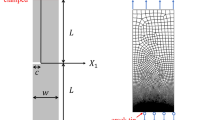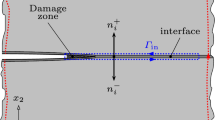Abstract
The Pure Shear (PS) crack specimen is widely employed to assess the fracture toughness of soft elastic materials. It serves as a valuable tool for investigating the behavior of crack growth in a steady-state manner following crack initiation. One of its advantages lies in the fact that the energy release rate (J) remains approximately constant for sufficiently long cracks, independent of crack length. Additionally, the PS specimen facilitates the easy evaluation of J for long cracks by means of a tension test conducted on an uncracked sample. However, the lack of a published expression for short cracks currently restricts the usefulness of this specimen. To overcome this limitation, we conducted a series of finite element (FE) simulations utilizing three different constitutive models, namely the neo-Hookean (NH), Arruda-Boyce (AB), and Mooney-Rivlin (MR) models. Our finite element analysis (FEA) encompassed practical crack lengths and strain levels. The results revealed that under a fixed applied displacement, the energy release rate (J) monotonically increases with the crack length for short cracks, reaches a steady-state value when the crack length exceeds the height of the specimen, and subsequently decreases as the crack approaches the end of the specimen. Drawing from these findings, we propose a simple closed-form expression for J that can be applied to most hyper-elastic models and is suitable for all practical crack lengths, particularly short cracks.










Similar content being viewed by others
References
Arruda EM, Boyce MC (1993) A three-dimensional constitutive model for the large stretch behavior of rubber elastic materials. J Mech Phys Solids 41:389–412. https://doi.org/10.1016/0022-5096(93)90013-6
Greensmith HW (1963) Rupture of rubber. X. The change in stored energy on making a small cut in a test piece held in simple extension. J Appl Polym Sci 7:993–1002. https://doi.org/10.1002/app.1963.070070316
Kahle E, Ehret AE, Mazza E (2023) The influence of aspect ratio on the determination of tearing energy in mode I fracture tests. Eng Fract Mech. https://doi.org/10.1016/j.engfracmech.2023.109315
Knowles JK, Sternberg E (1972) On a class of conservation laws in linearized and finite elastostatics. Arch Ration Mech Anal 44:187–211. https://doi.org/10.1007/BF00250778
Mooney M (1940) A theory of large elastic deformation. J Appl Phys 11:582–592. https://doi.org/10.1063/1.1712836
Pan Y, Zhou Y, Suo Z, Lu T (2023) Inelastic zone around crack tip in polyacrylamide hydrogel identified using digital image correlation. Eng Fract Mech 289:109435. https://doi.org/10.1016/j.engfracmech.2023.109435
Pidaparti RMV, Yang TY, Soedel W (1989) A plane stress finite element method for the prediction of rubber fracture. Int J Fract 39:255–268. https://doi.org/10.1007/BF00017700
Qi Y, Zou Z, Xiao J, Long R (2019) Mapping the nonlinear crack tip deformation field in soft elastomer with a particle tracking method. J Mech Phys Solids 125:326–346. https://doi.org/10.1016/j.jmps.2018.12.018
Rice JR (1968) A path independent integral and the approximate analysis of strain concentration by notches and cracks. J Appl Mech Trans ASME 35:379–388. https://doi.org/10.1115/1.3601206
Rivlin RS (1948a) Large elastic deformations of isotropic materials. IV. Further developments of the general theory. Collected Papers of R.S. Rivlin 241. https://doi.org/10.1007/978-1-4612-2416-7_9
Rivlin RS (1948b) Large elastic deformations of isotropic materials. I. Fundamental concepts. Philos Trans R Soc Lond Ser A 240:459–490. https://doi.org/10.1098/rsta.1948.0002
Rivlin RS, Thomas AG (1953) Rupture of rubber. I. Characteristic energy for tearing. J Polym Sci 10:291–318. https://doi.org/10.1002/pol.1953.120100303
Stoček R, Heinrich G, Gehde M, Kipscholl R (2013) Analysis of dynamic crack propagation in elastomers by simultaneous tensile- and pure-shear-mode testing. In: Fracture Mechanics and Statistical Mechanics of Reinforced Elastomeric Blends, pp 269–301. https://doi.org/10.1007/978-3-642-37910-9_7
Tanaka Y, Kuwabara R, Na YH, Kurokawa T, Gong JP, Osada Y (2005) Determination of fracture energy of high strength double network hydrogels. J Phys Chem B 109:11559–11562. https://doi.org/10.1021/jp0500790
Treloar L (1944) Stress-strain data for vulcanized rubber under various types of deformation. Rubber Chem Technol 17:813–825
Wang, J., Zhu, B., Hui, C.-Y., Zehnder, A.T., 2023. Delayed fracture caused by time-dependent damage in PDMS. J Mech Phys Solids 181:105459. https://doi.org/10.1016/j.jmps.2023.105459
Yeoh OH (2001) Analysis of deformation and fracture of “pure shear” rubber testpiece. Plast Rubber Compos Process Appl 30:389–397. https://doi.org/10.1179/146580101101541787
Zhang Y, Fukao K, Matsuda T, Nakajima T, Tsunoda K, Kurokawa T, Gong JP (2022) Unique crack propagation of double network hydrogels under high stretch. Extreme Mech Lett. https://doi.org/10.1016/j.eml.2021.101588
Zheng Y, Matsuda T, Nakajima T, Cui W, Zhang Y, Hui CY, Kurokawa T, Gong JP (2021) How chain dynamics affects crack initiation in double-network gels. Proc Natl Acad Sci USA. https://doi.org/10.1073/pnas.2111880118
Acknowledgements
This work is supported by the National Science Foundation, under Grant No. CMMI-1903308.
Author information
Authors and Affiliations
Contributions
CH and AZ designed and directed the project. BZ and JW performed the numerical simulations. All authors analyzed the data, and contributed to writing and reviewing the manuscript.
Corresponding author
Ethics declarations
Competing interests
The authors declare no competing interests.
Additional information
Publisher's Note
Springer Nature remains neutral with regard to jurisdictional claims in published maps and institutional affiliations.
Supplementary Information
Below is the link to the electronic supplementary material.
Rights and permissions
Springer Nature or its licensor (e.g. a society or other partner) holds exclusive rights to this article under a publishing agreement with the author(s) or other rightsholder(s); author self-archiving of the accepted manuscript version of this article is solely governed by the terms of such publishing agreement and applicable law.
About this article
Cite this article
Zhu, B., Wang, J., Zehnder, A.T. et al. Energy release rate of a mode-I crack in pure shear specimens subjected to large deformation. Int J Fract 245, 171–182 (2024). https://doi.org/10.1007/s10704-023-00751-6
Received:
Accepted:
Published:
Issue Date:
DOI: https://doi.org/10.1007/s10704-023-00751-6




